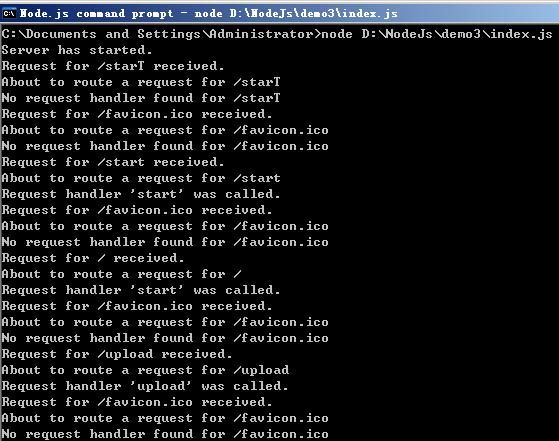Node.js零起点开发(五)-路由后添加有返回值(return)的处理函数
不好的实现方式
对于我们这样拥有PHP或者Ruby技术背景的开发者来说,最直截了当的实现方式事实上并不是非常靠谱: 看似有效,实则未必如此。
这里我指的“直截了当的实现方式”意思是:让请求处理程序通过onRequest函数直接返回(return())他们要展示给用户的信息。
我们先就这样去实现,然后再来看为什么这不是一种很好的实现方式。
对于我们这样拥有PHP或者Ruby技术背景的开发者来说,最直截了当的实现方式事实上并不是非常靠谱: 看似有效,实则未必如此。
这里我指的“直截了当的实现方式”意思是:让请求处理程序通过onRequest函数直接返回(return())他们要展示给用户的信息。
我们先就这样去实现,然后再来看为什么这不是一种很好的实现方式。
requestHandlers的模块
应用程序需要新的部件,因此加入新的模块 -- 已经无需为此感到新奇了。我们来创建一个叫做requestHandlers的模块,并对于每一个请求处理程序,添加一个占位用函数,随后将这些函数作为模块的方法导出:
requestHandlers的模块,并对于每一个请求处理程序,添加一个有返回值的函数,随后将这些函数作为模块的方法导出:
requestHandlers.js
function start() {
console.log("Request handler 'start' was called.");
return "Hello Start";
}
function upload() {
console.log("Request handler 'upload' was called.");
return "Hello Upload";
}
exports.start = start;
exports.upload = upload;
router模块
通过检查给定的路径对应的请求处理程序是否存在,如果存在的话直接调用相应的函数,并返回相应是字符串
router.js
function route(handle, pathname) {
console.log("About to route a request for " + pathname);
if (typeof handle[pathname] === 'function') {
return handle[pathname]();
} else {
console.log("No request handler found for " + pathname);
return "404 Not found";
}
}
exports.route = route;
server模块
处理请求模块
server.js
var http = require("http");
var url = require("url");
function start(route, handle) {
function onRequest(request, response) {
var pathname = url.parse(request.url).pathname;
console.log("Request for " + pathname + " received.");
response.writeHead(200, {"Content-Type": "text/plain"});
//处理不同的输出
var content = route(handle, pathname)
response.write(content);
response.end();
}
http.createServer(onRequest).listen(8888);
console.log("Server has started.");
}
exports.start = start;
index模块
启动模块,主模块
index.js
var server = require("./server");
var router = require("./router");
var requestHandlers = require("./requestHandlers");
//区分大小写的
var handle = {}
handle["/"] = requestHandlers.start;
handle["/start"] = requestHandlers.start;
handle["/upload"] = requestHandlers.upload;
server.start(router.route, handle);
运行后效果
如果现在启动应用(node index.js,始终记得这个命令行),随后请求一个URL,我请求的分别是是http://localhost:8888/starT,http://localhost:8888/start,http://localhost:8888/,http://localhost:8888/upload,你将会看到应用输出相应的信息,这表明我们的HTTP服务器已经在使用路由模块了,并会将请求的路径传递给路由,路由再找到对应的处理函数:
好,那么问题在哪里呢?简单的说就是: 当未来有请求处理程序需要进行非阻塞的操作的时候,我们的应用就“挂”了。
